Managing chronic conditions care across primary care and hospital systems: lessons from an Australian Hospital Avoidance Risk Program using the Flinders Chronic Condition Management Program
Sharon Lawn A E , Sara Zabeen A , David Smith A , Ellen Wilson B , Cathie Miller C , Malcolm Battersby A and Kevin Masman DA Flinders Human Behaviour and Health Research Unit, Department of Psychiatry, School of Medicine, Flinders University, GPO Box 2100, Adelaide, SA, 5001, Australia. Email: sara.zabeen@flinders.edu.au; david.smith@flinders.edu.au; Malcolm.battersby@flinders.edu.au
B Hospital Admission Risk Program, Post-Acute Care, Community Health Programs and Diabetes Service, Bendigo Health, 100 Barnard St., Bendigo, 3550, Vic., Australia. Email: ewilson@bendigohealth.org.au
C Hospital Admission Risk Program, Healthy Communities and Continuing Care, Bendigo Health, 100 Barnard St., Bendigo, 3550, Vic., Australia. Email: cmiller@bendigohealth.org.au
D Collaborative Health Education and Research Centre, Organisational Development and Improvement, Bendigo Health, 100 Barnard St., Bendigo, 3550, Vic., Australia. Email: kmasman@bendigohealth.org.au
E Corresponding author. Email: sharon.lawn@flinders.edu.au
Australian Health Review 42(5) 542-549 https://doi.org/10.1071/AH17099
Submitted: 29 January 2017 Accepted: 10 July 2017 Published: 24 August 2017
Journal compilation © AHHA 2018 Open Access CC BY-NC-ND
Abstract
Objective The study aimed to determine the impact of the Flinders Chronic Condition Management Program for chronic condition self-management care planning and how to improve its use with Bendigo Health’s Hospital Admission Risk Program (HARP).
Methods A retrospective analysis of hospital admission data collected by Bendigo Health from July 2012 to September 2013 was undertaken. Length of stay during admission and total contacts post-discharge by hospital staff for 253 patients with 644 admissions were considered as outcome variables. For statistical modelling we used the generalised linear model.
Results The combination of the HARP and Flinders Program was able to achieve significant reductions in hospital admissions and non-significant reduction in emergency department presentations and length of stay. The generalised linear model predicted that vulnerable patient groups such as those with heart disease (P = 0.037) and complex needs (P < 0.001) received more post-discharge contacts by HARP staff than those suffering from diabetes, renal conditions and psychosocial needs when they lived alone. Similarly, respiratory (P < 0.001), heart disease (P = 0.015) and complex needs (P = 0.050) patients had more contacts, with an increased number of episodes than those suffering from diabetes, renal conditions and psychosocial needs.
Conclusion The Flinders Program appeared to have significant positive impacts on HARP patients that could be more effective if high-risk groups, such as respiratory patients with no carers and respiratory and heart disease patients aged 0–65, had received more targeted care.
What is known about the topic? Chronic conditions are common causes of premature death and disability in Australia. Besides mental and physical impacts at the individual level, chronic conditions are strongly linked to high costs and health service utilisation. Hospital avoidance programs such as HARP can better manage chronic conditions through a greater focus on coordination and integration of care across primary care and hospital systems. In support of HARP, self-management interventions such as the Flinders Program aim to help individuals better manage their medical treatment and cope with the impact of the condition on their physical and mental wellbeing and thus reduce health services utilisation.
What does this paper add? This paper sheds light on which patients might be more or less likely to benefit from the combination of the HARP and Flinders Program, with regard to their impact on reductions in hospital admissions, emergency department presentations and length of stay. This study also sheds light on how the Flinders Program could be better targeted towards and implemented among high-need and high-cost patients to lessen chronic disease burden on Australia’s health system.
What are the implications for practitioners? Programs targeting vulnerable populations and applying evidence-based chronic condition management and self-management support achieve significant reductions in potentially avoidable hospitalisation and emergency department presentation rates, though sex, type of chronic condition and living situation appear to matter. Benefits might also accrue from the combination of contextual factors (such as the Flinders Program, supportive service management, clinical champions in the team) that work synergistically.
Introduction
In Australia, chronic conditions such as heart disease, diabetes, respiratory, and behavioural disorders feature as common causes of premature death and disability.1 In 2012, ischaemic heart disease was the leading cause of death in Australia, responsible for 21 300 deaths.2 Besides mental and physical impairments at the individual level, chronic conditions are strongly linked to high costs and health services utilisation. The Australian government spent approximately $21 billion on healthcare for chronic conditions in 2008–09, accounting for 29% of total health expenditure.1 Over half of this expenditure was for hospital-based admitted patient services, a significant portion of which was potentially avoidable.3
Hospital avoidance programs can better manage chronic conditions through a greater focus on coordination and integration of care across primary care (including general practice and community-based primary healthcare nursing and allied healthcare providers) and hospital systems.4–6 Improved discharge processes, follow-up and monitoring, quality use of medicine to minimise medication errors in the community, and chronic condition self-management education are some core components of such programs.3,7,8 Self-management interventions aim to help individuals better manage their medical treatment and cope with the impact of the condition on their physical and mental wellbeing.8 One such intervention is the Flinders Chronic Condition Management (CCM) Program, which was initiated during 2000–2004.9
The Flinders Program has been implemented as the model of care underpinning CCM and self-management support across a range of service types within Australia, such as a community aged care, general practice, primary health care community clinics, transition care from hospital to community services, and rehabilitation services. It has been used by a rehabilitation service in Adelaide for more than 12 years, and a large primary healthcare service serving a large area of western Victoria for more than 10 years. Evidence for the acceptability and effectiveness of the Flinders Program has been found among patients with a range of chronic physical and behavioural health conditions.10–13
The Bendigo Health Hospital Admission Risk Program (HARP) in Victoria is an example of a service that has implemented the Flinders Program as the model of care planning for their high-cost and high-needs patients, and has collected clinical data from patients over several years. Both programs are largely based on the principles of Wagner’s Chronic Care Model, which is an evidence-based systems framework that assists in the coordination, communication and management of care through a more collaborative approach between patient and healthcare professionals.14,15
This generic person-centred approach also supports disease-specific care planning and provides an inherent structure for doctors, nurses and allied health professionals within a practice or service to implement CCM.15 The health professional uses cognitive behavioural principles for cycles of care planning, review and monitoring to facilitate patient behavioural change. The health professional is trained to act as coach and coordinator of the person’s services.10 More information about the Flinders Program process is provided in Box 1.
| Box 1. Description of the Flinders Program9 |
| The Flinders Program is a generic chronic condition self-management support care planning process aiming to tailor medical and psychosocial interventions to meet a person’s needs while simultaneously motivating them to achieve their medical, social, emotional, and lifestyle risk factor goals. The person’s self-management capabilities are assessed by the person and health professional using a validated Likert self-rated tool known as the Partners in Health Scale,16 containing 12 questions covering the domains for effective self-management (knowledge of conditions and treatments; engagement with healthcare providers; access to services; monitoring and responding to signs and symptoms; physical, social and emotional impacts; and lifestyle risk factors such as smoking, diet, exercise, alcohol and stress). |
| The person and health professional then undertake a motivational interview to elicit more information about the person’s strengths and barriers to self-management in these domains, agreeing on areas of self-management that the person is doing well and not so well, and where they have discrepant views. From this shared dialogue, and comparison of their Likert scores for each domain, areas for further work are agreed and form the basis for the care plan (issues, aims, steps to get there, who is responsible, review data). For this dialogue the person also identifies a key problem for them, which can be medical or psychosocial, and sets a SMART (specific, measurable, action-based, realistic, timely) goal to address that problem, and this is also listed on the care plan which is then communicated across service providers, with a copy also provided to the person with the chronic condition(s). |
This study sought to better understand the impact of the Flinders Program on Bendigo Health’s HARP in managing chronic conditions by investigating whether there were any differences in impact for patients (length of hospital stay and number of contacts post-discharge from hospital) according to broad chronic condition type and sociodemographic variables such as age, sex, living situation, and presence of informal carer support.
Methods
Study design
This study is a retrospective analysis of hospital admission data collected by Bendigo Health from July 2012 to September 2013.
Bendigo Health and the Bendigo HARP Services
Bendigo Health is located regionally in central Victoria, in South Eastern Australia. It serves 56 965 km2, or 26%, of Victoria and a population of ~102 000. The city of Bendigo (population ~310 000) is located approximately 2 hours inland of the state’s capital, Melbourne. The Greater Bendigo region also includes several smaller rural towns and remote regions.17 The Bendigo HARP is one of several HARP services that have been mainstreamed following extensive piloting between 2007 and 2010 in Victoria. Victoria’s HARP services now sit within the larger Hospital Independence Program (HIP) that covers the state. The HARP service delivery model is based on the Kaiser Permanente Chronic Care framework (serving the needs of patients in Levels 1 and 2 – Intensive Care Coordination) and the Chronic Care Model.14,15,18 The HARP team is made up of several health professionals and includes specialist nursing, occupational therapy, physiotherapy, psychology, and social work staff. An interdisciplinary approach to patient care ensures team members work together towards the common goal of improving patients’ journey. Staff specialise in providing psychosocial care coordination to patients with complex medical conditions, as well as complex aged care issues (e.g. chronic respiratory, heart or kidney disease, diabetes).19,20 Patients who require psychosocial management include those who are homeless, have mental health issues, or drug and alcohol issues. Psychosocial management is flexible, to better adapt to the complexities of presenting needs of the target patient cohort.19 HARP provides specialist medical care and multidisciplinary services through an integrated response by hospital and community services, delivered in hospital, community and home-based settings. Victoria led the way in implementing the HARP approach in Australia and it has been emulated by many other Australian states. HARP provided strong evidence to the 2015 Senate Select Committee hearings across Australia that reviewed best evidence to guide policy directions for CCM across the Australian primary healthcare system.
The Bendigo HARP adopted full integration of the Flinders Program into their service systems early, aiming to build chronic condition self-management (CCSM) support for patients with chronic and complex care needs. Flinders Program training was provided to HARP health professionals in early 2012, with implementation support provided to the HARP team from mid-2012 to September 2013 (Fig. 1), by which time the program was fully embedded within the HARP and associated clinical systems.
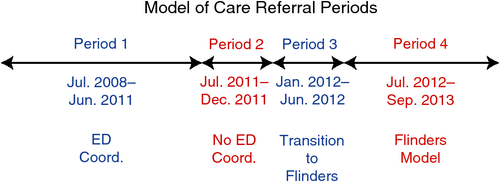
|
The training demonstrated how Flinders Program care planning tools supported the HARP’s core mission, key performance indicators and outcomes (mitigating the risk of emergency department (ED) presentations and inpatient admissions and readmissions), and this benefit was also recognised and supported by those managing the HARP service (R Liddicoat, C. Miller unpubl. data, 22 July 2014). A model of implementation was also developed to better integrate the Flinders Program into the HARP. The Flinders Program allowed person-centred care to develop and encouraged the HARP clinicians to step back and allow patients to have more say in their own care. Stepwise implementation of the Flinders Program included detailed negotiation with local community services and general practices to establish clinical pathways for patients to be retained and transferred back into the community once the self-management support was completed. This support lasted for up to 6 months. This enabled the clinical team to maintain a throughput of new cases, engaging with up to 750 new patients per year.
Precursor to the current study and its methods
During the initial months of implementation of the Flinders Program, the HARP data custodian conducted some statistical comparisons among the four periods (1, development of focus on emergency department coordination; 2, reduced emergency department focus; 3, transition to Flinders Program; 4, full Flinders Program adoption and implementation) (Fig. 1) and found that the Flinders Period (period 4) seemed to be having a positive impact on the services and on admission rates. They contacted the Flinders Program research team at Flinders University to alert them to these positive results, prompting the present analysis (K. Masman pers. comm. 16 June 2015). These initial results encouraged the authors to look into demographic and clinical predictors that impacted patients’ length of stay (LOS) during the Flinders Program period, because it is an important metric of quality care assessment and resource management.21 This paper also looked into the predictors that determined the number of contacts made with the patients once they were discharged from the hospital. Together, understanding these data and processes can help guide policy makers and clinical leaders to make more precise and selective decisions on how to implement the Flinders Program, and CCSM support more generally, into practice in the future.
Source of data, ethical clearance and sample characteristics
For this study, basic demographic, episode, and patient contact information was extracted by the HARP team. The ED data is stored in the Bendigo Health clinical repository database. The study was approved by the Bendigo Health Human Research Ethics Committee.
Statistical analysis
Statistical analyses were conducted using Stata 14.1 (StataCorp, College Station, TX, USA) for Flinders Period data drawn from the wider study conducted at Bendigo Health. For the current study, 644 admissions were analysed. LOS data was positively skewed and therefore recoded into a categorical variable based on the initial mean LOS of the current study (6.8 days), most recent average LOS in Australia (5.7 days) for leading chronic conditions1 and other similar studies.21 The three LOS categories were: shorter stay (0–4 days, n = 330, 51.2%); average stay (5–7 days, n = 134, 20.8%); and longer stay (>7 days, n = 180, 20.8%).
Similarly, the variable ‘total contact counts’ was log-transformed to minimise its skewness.22 The new variable showed a mean of 0.85 (s.d. = 0.43). For statistical modelling of predictors of LOS we used multinomial logistic regression. To account for patient clustering, robust standard errors were calculated. Variable selections for regression models commenced with univariate analyses and were selected for model advancement based on P < 0.25.23 Subject matter knowledge (previous literature and expert’s opinion) was also used in some instances in selecting variables even if P > 0.25. The final model was created with all selected variables at P < 0.05. To interpret effect sizes, relative risk ratios were calculated to represent the outcome of experiencing one level of outcome category (shorter or longer stay) relative to the reference category ‘average LOS’. A generalised linear model24 was conducted for modelling predictors of total contact counts and effect sizes were interpreted using odds ratios.
Results
In total, 253 patients experienced 644 admissions during the study period. Table 1 presents patient demographic and clinical characteristics.
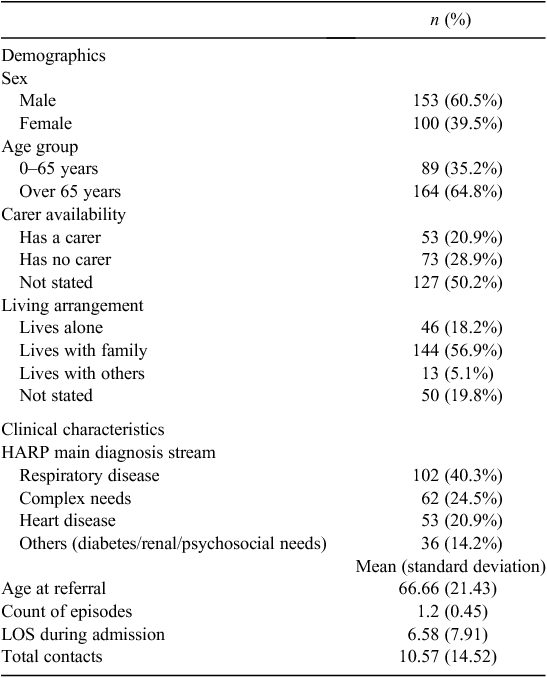
|
Regression models
Predictors of length of hospital stay
To investigate the variables and their statistical impacts on the outcome variable LOS, a multinomial regression model was undertaken. Table 2 presents each variable’s association with LOS for univariate analyses.
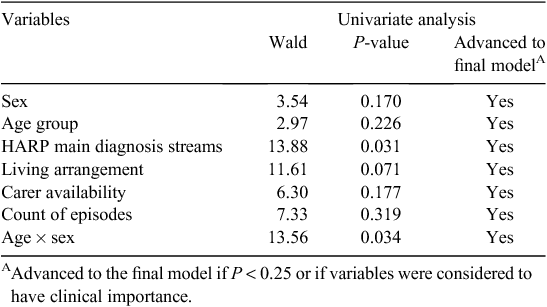
|
As seen in Table 2, all variables except ‘count of episodes’ met the cut-off criteria of P < 0.25 and therefore, were included in the final model. However, the variable ‘count of episodes’ was still advanced to the final model as Martin-Carrasco et al. suggested that more previous episodes lead towards longer stay in the hospital for people with chronic conditions such as those with greater psychosocial needs.25 The final model presented the combined effect of sex, episodes, age group, HARP diagnosis stream, living arrangement, carer availability and age bysex on patients’ LOS, which is presented in Table 3.
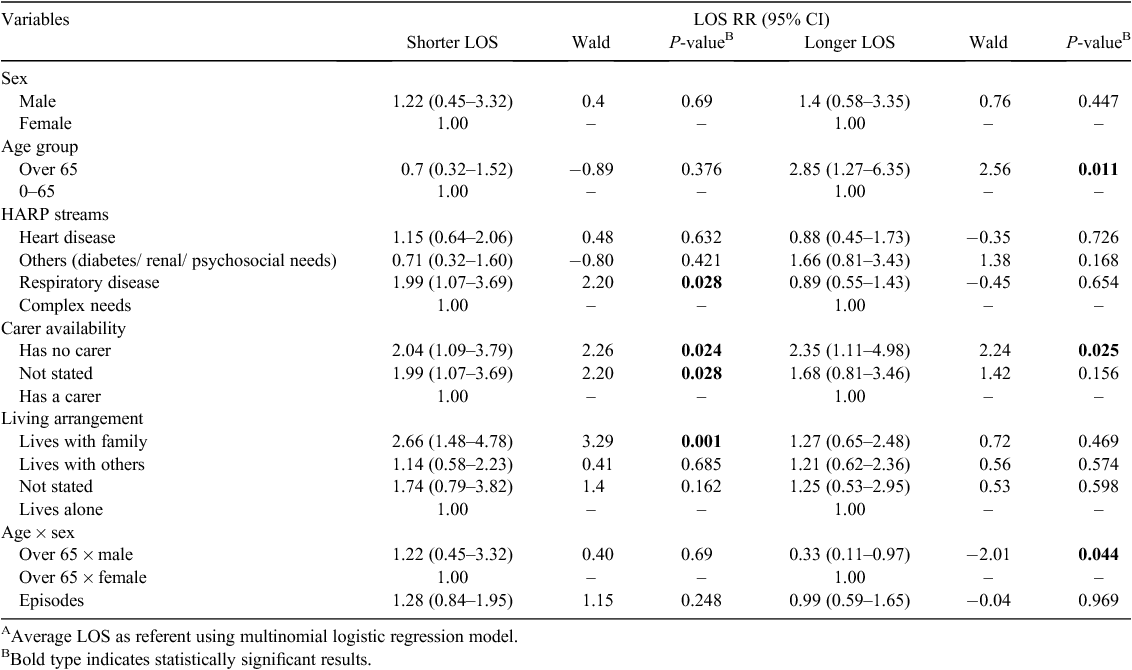
|
Table 3 shows that male patients aged over 65 years were 0.33 times less likely to be in the ‘longer LOS’ category than females of the same age. The results also showed that patients aged over 65, and those without any carer, were more likely to be in the ‘longer LOS’ category than their respective reference categories.
On the other hand, patients who had respiratory diseases were more likely to be in the ‘shorter LOS’ category than those who had ‘complex needs’. Also, patients who lived with their family were 2.66 times more likely to be in the ‘shorter LOS’ category than those who lived alone. There were no statistically significant effects for the remaining variables.
Predictors of total contacts
This study also looked into the predictors of total number of contacts post-discharge (Table 4).
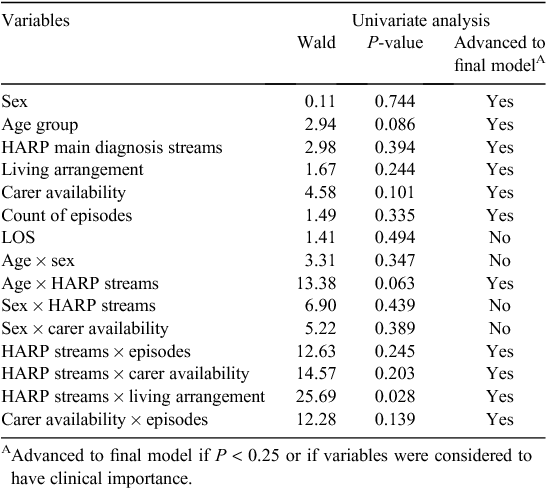
|
The sex variable and the HARP streams variable were advanced to the final model as intuitively they were deemed relevant predictors of post-discharge total contacts. Table 5 presents results of the final model.
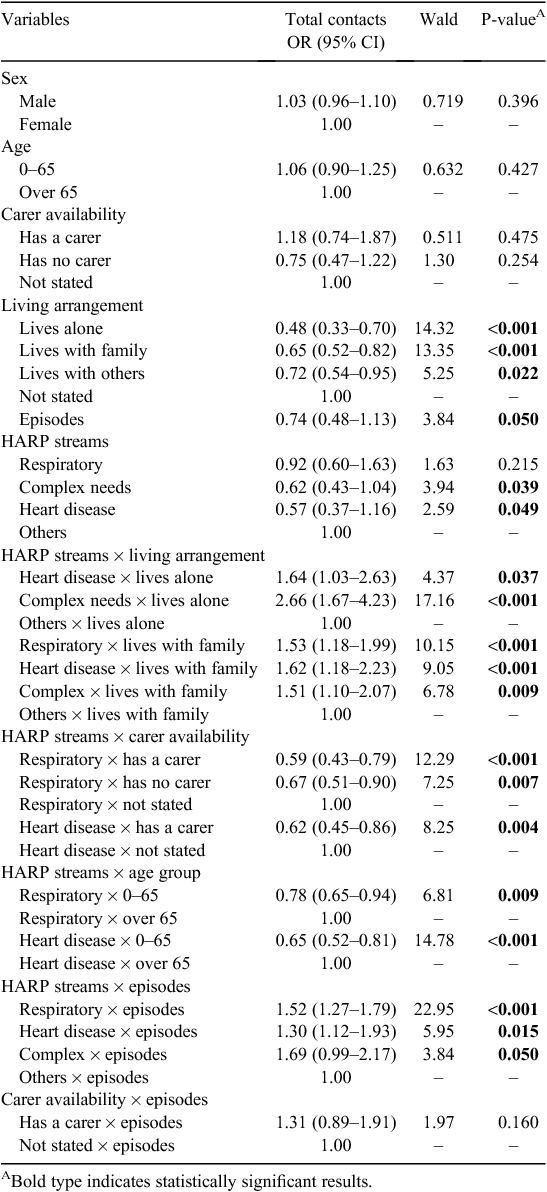
|
Table 5 shows that patients who lived alone, with family or others, diagnosed with complex needs or heart disease, respiratory patients with or without carer, heart disease patients with carer, and both respiratory and heart disease patients aged 0–65 were less likely to be contacted by hospital staff than their respective reference categories. There were also fewer contacts with patients with increased number of episodes.
Alternatively, patients with heart disease or complex needs, whether living alone or with family, and respiratory patients living with family, had more contacts than their reference categories. Similarly, the model showed that with an increased number of episodes, patients diagnosed with respiratory, heart disease or complex needs, and those who had carers had more contacts following discharge from hospital.
Discussion
Globally, encouraging self-management care planning has been viewed as one means of reducing health service utilisation and contributing to improved demand management among patients with chronic conditions.26–29 Existing research has already identified population subgroups that are at greater risk of both future hospitalisation and rehospitalisation.3,30–33 The findings of this study have also revealed subgroups of patients who may warrant a more concentrated focus on self-management practices to reduce healthcare utilisation.34
Hospital LOS is one such vital metric of resource utilisation and patient care. Predictors of hospital LOS provide essential information to help identify and reduce rehospitalisation rates in subgroups of patients. The final model of predictors of LOS showed that male patients, patients aged 0–65 and those diagnosed with respiratory disease were less likely to be in ‘longer LOS’ category. Initial HARP results reported that outcomes for respiratory disease were less positive than other disease streams (R Liddicoat, C. Miller unpubl. data, 22 July 2014). A possible reason could be respiratory patients’ shorter LOS (<5 days; 57.5%, n = 142). Carey and Lin found that, for every 1-day increase in LOS, there was a corresponding reduction in the risk of readmission for patients with similar chronic conditions such as heart disease.35 This is of particular importance as Erny-Albrecht et al. reported that respiratory disease is the most common chronic disease with potentially avoidable hospitalisation through a continuum of care model.3 Interestingly, male patients responded better to the Flinders Program than females (R Liddicoat, C. Miller unpubl. data, 22 July 2014), although most of them also had shorter LOS (48.7%, n = 184), which warrants further research.
Another important way to prevent rehospitalisation is for health professionals to contact patients regularly post-discharge. As Pruitt et al. recommended, the most prevalent health problems such as diabetes, asthma, heart disease, and depression require extended and regular healthcare contact.36 The Flinders Program aims to achieve that goal by making face-to-face, telephone or email contacts as part of planned care. Overall results showed that patients diagnosed with heart disease or complex needs and without a carer received more contacts whether they lived alone or with family. This is particularly positive given having no carer and living alone are acknowledged as barriers to effective CCM.30 Similarly, respiratory, complex needs and heart disease patients with an increased number of episodes received more contacts. Previous research has shown that respiratory3 or heart disease patients31,37 and patients with more previous hospital episodes25 needed long-term contact and intense monitoring for better management. Thus, some vulnerable patient groups received effective health intervention through HARP and the Flinders Program; whereas, results also showed that patients who lived alone, male patients diagnosed with complex needs, heart disease patients aged 0–65 and respiratory patients who did not have any carer were less likely to be able to be contacted, indicating further research is needed.
Findings of the HARP research team
The HARP team reported that diabetic patients responded well to the Flinders Program compared with others, most likely due to diabetes’ manageable nature (K. Masman pers. comm. 16 June 2015). Elderly males (over 65) also showed more improvement than elderly females, and this demands further exploration. The Flinders Program was least effective among patients with end-stage chronic diseases (K. Masman pers. comm. 16 June 2015). A possible reason is that this cohort (aged over 85) is too complex,34 suggesting the need for further research to determine the boundary between active CCM and palliative care, and the concepts of CCM and CCSM for this population.
Finally, although neither this study nor the original HARP study found any significant differences in age groups (K. Masman pers. comm. 16 June 2015), existing literature suggests that people aged 0–4, 20–2938 and those over 7539,40 are the most vulnerable populations in terms of CCM. Of particular importance are younger populations who tend to gain more out of self-management programs due to a generally more positive attitude towards new interventions.41 Older populations also need special monitoring, as Fan et al. suggested that regular follow-up can reduce ED presentations in this population cohort.42
Study limitations
This cross-sectional study was unable to explain causal links between variables. Also, categorical variables such as living arrangements and carer availability have levels such as ‘not stated’ (n = 122 and n = 281 respectively), which potentially hampered results of the overall model and made it harder to interpret the outcomes. Some of the variables such as age group and HARP stream needed to be collapsed and thus we could not analyse impacts of all subcategories. These limitations suggest that more robust studies are needed, including a prospective longitudinal study to better understand individual trajectories of change over time and the role of self-management interventions from a temporal perspective.
Conclusion
Pruitt et al. state that healthcare for patients with chronic conditions does not end or begin at the doorway of the hospital.36 It has to extend beyond hospital walls and infuse patients’ living and working environments. Demographic, clinical and social contexts related to one’s experience of living with a long-term illness and history of health service utilisation are relevant to understand the impact of CCSM support programs aimed at bringing about changes in service use.26 Programs targeting vulnerable populations and those including multidisciplinary teams achieve the greatest significant reductions in potentially avoidable hospitalisation and ED presentation rates.3,43 The HARP incorporating the Flinders Program was able to achieve significant reduction in hospital admissions and non-significant reduction in ED presentations and LOS. The HARP research team noted that benefits might accrue from the combination of contextual factors (Flinders Program, supportive service management, clinical champions in the team, etc.) that work synergistically.18 This study sheds some light on how the Flinders Program could be better targeted and implemented with high-need, high-cost patients to lessen chronic disease burden on Australia’s health system in the future.
Competing interests
The authors have no competing interests to declare.
Acknowledgements
We wish to thank Bendigo Health for its commitment to innovation in the care of people with chronic disease. This analysis was conducted within the authors’ existing resources and roles. No additional funding was sought.
References
[1] Australian Institute of Health and Welfare (AIHW). Australia’s health 2014. Australia’s health series no. 14, Cat. AUS 178. Canberra: AIHW; 2014.[2] World Health Organization (WHO). Australia: WHO statistical profile. Geneva : WHO; 2015. Available at http://www.who.int/gho/countries/aus.pdf [verified 24 January 2017].
[3] Erny-Albrecht K, Oliver-Baxter J, Bywood P. Primary health care-based programmes targeting potentially avoidable hospitalisations in vulnerable groups with chronic disease, Primary Health Care Research & Information Service policy issue review. Adelaide: Primary Health Care Research & Information Service; 2016.
[4] Thille P, Ward N, Russell G. Self-management support in primary care: enactments, disruptions and conversational consequences. Soc Sci Med 2014; 108 97–105.
| Self-management support in primary care: enactments, disruptions and conversational consequences.Crossref | GoogleScholarGoogle Scholar |
[5] Schulman-Green D, Jaser S, Martin F, Alonzo A, Grey M, Redeker N, Reynolds N, Whittemore R. Processes of self-management in chronic illness. J Nurs Scholarsh 2012; 44 136–44.
| Processes of self-management in chronic illness.Crossref | GoogleScholarGoogle Scholar |
[6] Lawn S, McMillan J, Pulvirenti M. Chronic condition self-management: expectations of responsibility. Patient Educ Couns 2011; 84 e5–8.
| Chronic condition self-management: expectations of responsibility.Crossref | GoogleScholarGoogle Scholar |
[7] Lawn S, Schoo A. Supporting self-management of chronic health conditions: common approaches. Patient Educ Couns 2010; 80 205–11.
| Supporting self-management of chronic health conditions: common approaches.Crossref | GoogleScholarGoogle Scholar |
[8] Lorig KR, Sobel DS, Ritter PL, Laurent D, Hobbs M. Effect of a self-management program on patients with chronic disease. Eff Clin Pract 2001; 4 256–62.
| 1:STN:280:DC%2BD38%2Fkt12hsw%3D%3D&md5=11c11058df1d41c2ba7190d5d6e52717CAS |
[9] Flinders Human Behaviour & Health Research Unit. The Flinders Chronic Condition Management Program information paper; 2016. Available at http://flindersprogram.com/about/information-paper/ [verified 24 January 2017]
[10] Battersby MW, Beattie J, Pols RG, Smith DP, Condon J, Blunden S. A randomised controlled trial of the Flinders Program™ of chronic condition management in Vietnam veterans with co-morbid alcohol misuse, and psychiatric and medical conditions. Aust N Z J Psychiatry 2013; 47 451–62.
| A randomised controlled trial of the Flinders Program™ of chronic condition management in Vietnam veterans with co-morbid alcohol misuse, and psychiatric and medical conditions.Crossref | GoogleScholarGoogle Scholar |
[11] Battersby M, Harris M, Smith D, Reed R, Woodman R. A pragmatic randomized controlled trial of the Flinders Program of chronic condition management in community health care services. Patient Educ Couns 2015; 98 1367–75.
| A pragmatic randomized controlled trial of the Flinders Program of chronic condition management in community health care services.Crossref | GoogleScholarGoogle Scholar |
[12] Harvey PW, Petkov J, Misan G, Warren K, Fuller J, Battersby M, Cayetano N, Holmes P. Self-management support and training for patients with chronic and complex conditions improves health related behaviour and health outcomes. Aust Health Rev 2008; 32 330–8.
| Self-management support and training for patients with chronic and complex conditions improves health related behaviour and health outcomes.Crossref | GoogleScholarGoogle Scholar |
[13] Lawn S, Battersby M, Pols RG, Lawrence J, Parry T, Urukalo M. The mental health expert patient: findings from a pilot study of a generic chronic condition self-management programme for people with mental illness. Int J Soc Psychiatry 2007; 53 63–74.
| The mental health expert patient: findings from a pilot study of a generic chronic condition self-management programme for people with mental illness.Crossref | GoogleScholarGoogle Scholar |
[14] Wagner EH, Austin B, Von Korff M. Organising care for patients with chronic illness. Milbank Q 1996; 74 511–44.
| Organising care for patients with chronic illness.Crossref | GoogleScholarGoogle Scholar | 1:STN:280:DyaK2s%2Fps1agtA%3D%3D&md5=968cfc1cef14bcbf146bcfa62b5f318eCAS |
[15] Wagner EH, Austin B, Davis C, Hindmarsh M, Schaefer J, Bonomi A. Improving chronic illness care: translating evidence into action. Health Aff (Millwood) 2001; 20 64–78.
| Improving chronic illness care: translating evidence into action.Crossref | GoogleScholarGoogle Scholar | 1:STN:280:DC%2BD38%2FovVagug%3D%3D&md5=79b58c0a48994816a4ffe08ef1380465CAS |
[16] Smith D, Harvey P, Lawn S, Harris M, Battersby M. Measuring chronic condition self-management in an Australian community: factor structure of the revised Partners in Health (PIH) scale. Qual Life Res 2017; 26 149–59.
| Measuring chronic condition self-management in an Australian community: factor structure of the revised Partners in Health (PIH) scale.Crossref | GoogleScholarGoogle Scholar |
[17] Bendigo Health. About Bendigo Health; 2013. Available at http://www.bendigohealth.org.au/index.asp [verified 24 January 2017]
[18] Mills T, Champion R, Masman K, Battersby M, Miller C, Liddicoat R. Evaluating a chronic disease health program. Bendigo: Bendigo Health HARP Program; unpublished 2012.
[19] Victoria State Government. Health Independence Program. Melbourne: Health Victoria; 2016. Available at: https://www2.health.vic.gov.au/hospitals-and-health-services/patient-care/rehabilitation-complex-care/health-independence-program/care-coordination [verified 24 January 2017]
[20] Bendigo Health. Bendigo Health Annual Report, 2013–2014. Bendigo: Bendigo Health; 2014.
[21] Freitas A, Silva-Costa T, Lopes F, Garcia-Lema I, Teixeira-Pinto A, Brazdil P, Costa-Pereira A. Factors influencing hospital high length of stay outliers. BMC Health Serv Res 2012; 12 265
| Factors influencing hospital high length of stay outliers.Crossref | GoogleScholarGoogle Scholar |
[22] Diehr P, Yanez D, Ash A, Hornbrook M, Lin DY. Methods for analysing health care utilization and costs. Annu Rev Public Health 1999; 20 125–44.
| Methods for analysing health care utilization and costs.Crossref | GoogleScholarGoogle Scholar | 1:STN:280:DyaK1M3otFWiuw%3D%3D&md5=41d2888f85f5ad9195c46b21feacaf2eCAS |
[23] Hosmer D, Lemeshow S. Applied logistic regression. 2nd ed. New York: Wiley; 2000.
[24] Nelder JA, Baker RJ. Generalized linear models. Encyclopaedia of statistical sciences; 1972.
[25] Martin-Carrasco M, Gonzalez-Pinto A, Galan JL, Ballesteros J, Maurino J, Vieta E. Number of prior episodes and the presence of depressive symptoms are associated with longer length of stay for patients with acute manic episodes. Ann Gen Psychiatry 2012; 11 7
| Number of prior episodes and the presence of depressive symptoms are associated with longer length of stay for patients with acute manic episodes.Crossref | GoogleScholarGoogle Scholar |
[26] Gately C, Rogers A, Sanders C. Re-thinking the relationship between long-term condition self-management education and the utilization of health services. Soc Sci Med 2007; 65 934–45.
| Re-thinking the relationship between long-term condition self-management education and the utilization of health services.Crossref | GoogleScholarGoogle Scholar |
[27] Penkunas MJ, Hahn-Smith S. Risk factors for psychiatric hospital admission for participants in California’s full-service partnership program. Community Ment Health J 2016; 52 651–7.
| Risk factors for psychiatric hospital admission for participants in California’s full-service partnership program.Crossref | GoogleScholarGoogle Scholar |
[28] Jerant AF, Friederichs-Fitzwaterb MM, Moore M. Patients’ perceived barriers to active self-management of chronic conditions. Patient Educ Couns 2005; 57 300–7.
| Patients’ perceived barriers to active self-management of chronic conditions.Crossref | GoogleScholarGoogle Scholar |
[29] Fabbian F, Boccafogli A, Giorgi AD, Pala M, Salmi R, Melandri R, Gallerani M, Gardini A, Rinaldi G, Manfredini R. The crucial factor of hospital readmissions: a retrospective cohort study of patients evaluated in the emergency department and admitted to the department of medicine of a general hospital in Italy. Eur J Med Res 2015; 20 6
| The crucial factor of hospital readmissions: a retrospective cohort study of patients evaluated in the emergency department and admitted to the department of medicine of a general hospital in Italy.Crossref | GoogleScholarGoogle Scholar |
[30] Longman JM, Rolfe MI, Passey MD, Heathcote KE, Ewald DP, Dunn T, Barclay LM, Morgan GG. Frequent hospital admission of older people with chronic disease: a cross-sectional survey with telephone follow-up and data linkage. BMC Health Serv Res 2012; 12 373
| Frequent hospital admission of older people with chronic disease: a cross-sectional survey with telephone follow-up and data linkage.Crossref | GoogleScholarGoogle Scholar |
[31] Krumholz HM, Chen Y-T, Wang Y, Vaccarino V, Radford MJ, Horwitz RI. Predictors of readmission among elderly survivors of admission with heart failure. Am Heart J 2000; 139 72–7.
| Predictors of readmission among elderly survivors of admission with heart failure.Crossref | GoogleScholarGoogle Scholar | 1:STN:280:DC%2BD3c%2Fos1Cquw%3D%3D&md5=89d9a1a0cbef3af13fcde7dc87e223a0CAS |
[32] Han S, Smith TS, Gunnar W. Descriptive analysis of 30-day readmission after inpatient surgery discharge in the veterans health administration. JAMA Surg. 2014; 149 1162–8.
| Descriptive analysis of 30-day readmission after inpatient surgery discharge in the veterans health administration.Crossref | GoogleScholarGoogle Scholar |
[33] Chan MF, Wong FKY. The risk factors for hospital re-admission in medical patients in Singapore. Health Soc Care Community 2014; 22 488–96.
| The risk factors for hospital re-admission in medical patients in Singapore.Crossref | GoogleScholarGoogle Scholar |
[34] Lewis GH. Impactibility models: identifying the subgroup of high-risk patients most amenable to hospital-avoidance programs. Milbank Q 2010; 88 240–55.
| Impactibility models: identifying the subgroup of high-risk patients most amenable to hospital-avoidance programs.Crossref | GoogleScholarGoogle Scholar |
[35] Carey K, Lin MY. Hospital length of stay and readmission: an early investigation. Med Care Res Rev 2014; 71 99–111.
| Hospital length of stay and readmission: an early investigation.Crossref | GoogleScholarGoogle Scholar |
[36] Pruitt S, Annandale S, Epping-Jordan J, Díaz JMF, Khan M, Kisa A, Klapow J, Solinis RN, Reddy S, Wagner E. Innovative care for chronic conditions: building blocks for action. Geneva: World Health Organization; 2002.
[37] Huntley A, Lasserson D, Wye L, Morris R, Checkland K, England H, Salisbury C, Purdy S. Which features of primary care affect unscheduled secondary care use? A systematic review. BMJ Open 2014; 4 e004746
| Which features of primary care affect unscheduled secondary care use? A systematic review.Crossref | GoogleScholarGoogle Scholar |
[38] Freed GL, Gafforini S, Carson N. Age distribution of emergency department presentations in Victoria. Emerg Med Australas 2015; 27 102–7.
| Age distribution of emergency department presentations in Victoria.Crossref | GoogleScholarGoogle Scholar |
[39] Li JY, Yong TY, Hakendorf P, Ben-Tovim DI, Thompson CH. Identifying risk factors and patterns for unplanned readmission to a general medical service. Aust Health Rev 2015; 39 56–62.
| Identifying risk factors and patterns for unplanned readmission to a general medical service.Crossref | GoogleScholarGoogle Scholar |
[40] Falster MO, Jorm LR, Douglas KA, Blyth FM, Elliott RF, Leyland AH. Sociodemographic and health characteristics, rather than primary care supply, are major drivers of geographic variation in preventable hospitalizations in Australia. Med Care 2015; 53 436–45.
| Sociodemographic and health characteristics, rather than primary care supply, are major drivers of geographic variation in preventable hospitalizations in Australia.Crossref | GoogleScholarGoogle Scholar |
[41] Packer TL, Boldy D, Ghahari S, Melling L, Parsons R, Osborne RH. Self-management programs conducted within a practice setting: who participates, who benefits and what can be learned? Patient Educ Couns 2012; 87 93–100.
| Self-management programs conducted within a practice setting: who participates, who benefits and what can be learned?Crossref | GoogleScholarGoogle Scholar |
[42] Fan L, Lukin W, Zhao J, Sun J, Hou XY. Interventions targeting the elderly population to reduce emergency department utilisation: a literature review. Emerg Med J 2015; 32 738–43.
| Interventions targeting the elderly population to reduce emergency department utilisation: a literature review.Crossref | GoogleScholarGoogle Scholar |
[43] van Loenen T, Van Den Berg MJ, Westert GP, Faber MJ. Organizational aspects of primary care related to avoidable hospitalization: A systematic review. Fam Pract 2014; 31 502–16.
| Organizational aspects of primary care related to avoidable hospitalization: A systematic review.Crossref | GoogleScholarGoogle Scholar |


